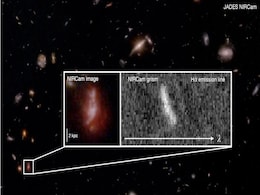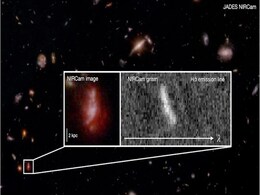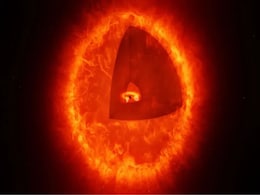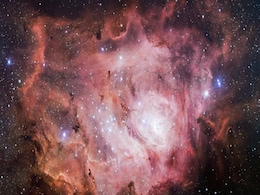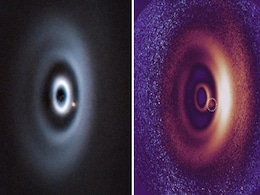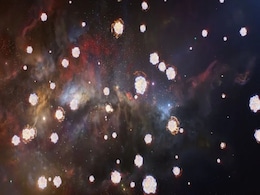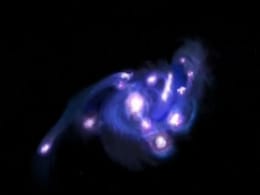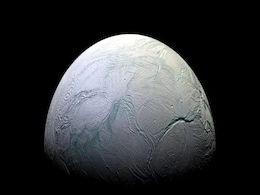Cosmic Formation
- All
- News
-

James Webb Confirms First Runaway Supermassive Black Hole Rocking Through Space
- Thursday December 18, 2025
The James Webb Space Telescope has confirmed the first runaway supermassive black hole, moving at 2.2 million mph through the Cosmic Owl galaxies. Pushing a galaxy-sized shockwave and leaving a long trail of star-forming gas, this discovery confirms long-standing theories about black hole ejections and opens the door to finding more cosmic speedste...
-
 www.gadgets360.com
www.gadgets360.com
-

James Webb Space Telescope Could Illuminate Dark Matter in an Unexpected Way
- Thursday December 18, 2025
New research suggests the James Webb Space Telescope could help uncover the true nature of dark matter. By observing strange, elongated galaxies in the early universe, scientists believe JWST may reveal how dark matter shaped cosmic structure, offering clues that could narrow down long-standing theories about this invisible substance.
-
 www.gadgets360.com
www.gadgets360.com
-

ESA Reveals City-Size ‘Cosmic Butterfly’ Crater on Mars Containing Signs of Ancient Water
- Wednesday December 17, 2025
ESA has captured a city-sized butterfly-shaped crater on Mars with smooth wings likely formed by melted underground ice. Studying this rare structure helps scientists understand asteroid impacts, Mars’ surface ice, and the planet’s ancient watery past while offering insight into how unusual crater formations develop on the Red Planet.
-
 www.gadgets360.com
www.gadgets360.com
-

Scientists Finds Galaxies Rotating Together Inside Massive Dark Matter Thread
- Saturday December 6, 2025
- Science |
The filament is a part of the vast cosmic web composed primarily of dark matter and interspersed with lighter layers of normal matter.
-
 www.ndtv.com
www.ndtv.com
-

Astronomers Spot Galaxies Moving in Sync Across a 50-Million-Light-Year Stretch
- Friday December 5, 2025
Astronomers have identified a 50-million-light-year-long cosmic filament in which 14 gas-rich galaxies all rotate in sync with the structure itself. The filament, mapped about 140 million light-years away, appears young, cold and shaped by slow cosmic flows. Galaxies on opposite ends move in opposite directions, suggesting the entire filament is sp...
-
 www.gadgets360.com
www.gadgets360.com
-

James Webb Telescope May Have Spotted First Generation of Stars in the Universe
- Sunday November 16, 2025
Astronomers using JWST may have discovered Population III stars in cluster LAP1-B, offering new insights into early galaxy formation and the universe’s first luminous objects. JWST observations suggest Population III stars may have formed 13 billion years ago, helping trace early galaxies. These stars might be building blocks for larger galaxies ...
-
 www.gadgets360.com
www.gadgets360.com
-

James Webb Telescope Finds Early Universe Galaxies Were More Chaotic Than We Thought
- Thursday October 23, 2025
The James Webb Space Telescope has revealed that galaxies in the early universe were far more chaotic and unstable than once believed. A new study shows that gas turbulence and intense star formation disrupted young galaxies, reshaping scientists’ understanding of how galaxies evolved into the structured systems seen today.
-
 www.gadgets360.com
www.gadgets360.com
-

James Webb Telescope Uncovers the Turbulent Birth of the First Galaxies
- Saturday October 25, 2025
Using JWST data, astronomers analyzed more than 250 galaxies from the universe’s first 1.5 billion years and found most were chaotic, with gas swirling in all directions. Only a few showed early signs of ordered rotation. The findings reveal how intense star formation and gravitational turbulence gave way to stability, transforming the early univ...
-
 www.gadgets360.com
www.gadgets360.com
-

NASA’s James Webb Telescope May Have Found First Black Hole Star, Known as ‘The Cliff’
- Thursday September 25, 2025
JWST detected “The Cliff,” a candidate black hole star with a black hole core wrapped in a luminous gas shell. This discovery offers insights into black hole formation, stellar evolution, and cosmic dynamics, prompting astronomers to search for similar objects across the universe.
-
 www.gadgets360.com
www.gadgets360.com
-

Universe’s First Stars May Have Been Smaller Than Astronomers Once Believed
- Tuesday September 9, 2025
Astronomers once thought the universe’s first stars were only massive giants. New simulations and lab experiments reveal turbulence and early chemistry allowed smaller, Sun-like stars to form too. This discovery reshapes our view of cosmic dawn, showing the first stellar generation was more diverse than previously believed.
-
 www.gadgets360.com
www.gadgets360.com
-

A Planet Is Being Born: Astronomers Capture Rare Cosmic Snapshot
- Saturday August 30, 2025
Astronomers have captured a groundbreaking sight: WISPIT 2b, a baby gas giant planet forming within a dusty, multi-ring protoplanetary disk around a young Sun-like star 430 light-years away. Infrared images from the Very Large Telescope show the planet carving a dark path in the rings as it feeds on gas and dust. This rare discovery provides the fi...
-
 www.gadgets360.com
www.gadgets360.com
-

Scientists Recreate Universe’s First Molecules, Challenging Early Star Formation Theories
- Tuesday August 19, 2025
Scientists have recreated helium hydride ions, the universe’s first molecules, under lab conditions. The study reveals these ions were far more effective in driving early star formation than older theories suggested. Published in Astronomy and Astrophysics, the research reshapes understanding of early cosmic chemistry and challenges assumptions a...
-
 www.gadgets360.com
www.gadgets360.com
-

Astronomers Discover "Cosmic Grapes" Galaxy Packed with Star-Forming Clumps in the Early Universe
- Friday August 15, 2025
The "Cosmic Grapes" galaxy discovery sheds new light on early galaxy formation, revealing unexpected dense, star-forming clumps just 930 million years post-Big Bang. Uncovered through JWST, ALMA, and gravitational lensing, this breakthrough opens new opportunities for understanding the early cosmos.
-
 www.gadgets360.com
www.gadgets360.com
-

Crystalline Ice Discovered in Space: New Study Reveals Hidden Order in Cosmic Ice
- Tuesday July 15, 2025
A groundbreaking study from University College London and the University of Cambridge reveals that water ice in space, long believed to be completely amorphous due to extreme cold, may actually contain up to 25% crystalline structure. Simulations and X-ray diffraction experiments confirm the presence of nanocrystals in so-called low-density amorpho...
-
 www.gadgets360.com
www.gadgets360.com
-

James Webb Confirms First Runaway Supermassive Black Hole Rocking Through Space
- Thursday December 18, 2025
The James Webb Space Telescope has confirmed the first runaway supermassive black hole, moving at 2.2 million mph through the Cosmic Owl galaxies. Pushing a galaxy-sized shockwave and leaving a long trail of star-forming gas, this discovery confirms long-standing theories about black hole ejections and opens the door to finding more cosmic speedste...
-
 www.gadgets360.com
www.gadgets360.com
-

James Webb Space Telescope Could Illuminate Dark Matter in an Unexpected Way
- Thursday December 18, 2025
New research suggests the James Webb Space Telescope could help uncover the true nature of dark matter. By observing strange, elongated galaxies in the early universe, scientists believe JWST may reveal how dark matter shaped cosmic structure, offering clues that could narrow down long-standing theories about this invisible substance.
-
 www.gadgets360.com
www.gadgets360.com
-

ESA Reveals City-Size ‘Cosmic Butterfly’ Crater on Mars Containing Signs of Ancient Water
- Wednesday December 17, 2025
ESA has captured a city-sized butterfly-shaped crater on Mars with smooth wings likely formed by melted underground ice. Studying this rare structure helps scientists understand asteroid impacts, Mars’ surface ice, and the planet’s ancient watery past while offering insight into how unusual crater formations develop on the Red Planet.
-
 www.gadgets360.com
www.gadgets360.com
-

Scientists Finds Galaxies Rotating Together Inside Massive Dark Matter Thread
- Saturday December 6, 2025
- Science |
The filament is a part of the vast cosmic web composed primarily of dark matter and interspersed with lighter layers of normal matter.
-
 www.ndtv.com
www.ndtv.com
-

Astronomers Spot Galaxies Moving in Sync Across a 50-Million-Light-Year Stretch
- Friday December 5, 2025
Astronomers have identified a 50-million-light-year-long cosmic filament in which 14 gas-rich galaxies all rotate in sync with the structure itself. The filament, mapped about 140 million light-years away, appears young, cold and shaped by slow cosmic flows. Galaxies on opposite ends move in opposite directions, suggesting the entire filament is sp...
-
 www.gadgets360.com
www.gadgets360.com
-

James Webb Telescope May Have Spotted First Generation of Stars in the Universe
- Sunday November 16, 2025
Astronomers using JWST may have discovered Population III stars in cluster LAP1-B, offering new insights into early galaxy formation and the universe’s first luminous objects. JWST observations suggest Population III stars may have formed 13 billion years ago, helping trace early galaxies. These stars might be building blocks for larger galaxies ...
-
 www.gadgets360.com
www.gadgets360.com
-

James Webb Telescope Finds Early Universe Galaxies Were More Chaotic Than We Thought
- Thursday October 23, 2025
The James Webb Space Telescope has revealed that galaxies in the early universe were far more chaotic and unstable than once believed. A new study shows that gas turbulence and intense star formation disrupted young galaxies, reshaping scientists’ understanding of how galaxies evolved into the structured systems seen today.
-
 www.gadgets360.com
www.gadgets360.com
-

James Webb Telescope Uncovers the Turbulent Birth of the First Galaxies
- Saturday October 25, 2025
Using JWST data, astronomers analyzed more than 250 galaxies from the universe’s first 1.5 billion years and found most were chaotic, with gas swirling in all directions. Only a few showed early signs of ordered rotation. The findings reveal how intense star formation and gravitational turbulence gave way to stability, transforming the early univ...
-
 www.gadgets360.com
www.gadgets360.com
-

NASA’s James Webb Telescope May Have Found First Black Hole Star, Known as ‘The Cliff’
- Thursday September 25, 2025
JWST detected “The Cliff,” a candidate black hole star with a black hole core wrapped in a luminous gas shell. This discovery offers insights into black hole formation, stellar evolution, and cosmic dynamics, prompting astronomers to search for similar objects across the universe.
-
 www.gadgets360.com
www.gadgets360.com
-

Universe’s First Stars May Have Been Smaller Than Astronomers Once Believed
- Tuesday September 9, 2025
Astronomers once thought the universe’s first stars were only massive giants. New simulations and lab experiments reveal turbulence and early chemistry allowed smaller, Sun-like stars to form too. This discovery reshapes our view of cosmic dawn, showing the first stellar generation was more diverse than previously believed.
-
 www.gadgets360.com
www.gadgets360.com
-

A Planet Is Being Born: Astronomers Capture Rare Cosmic Snapshot
- Saturday August 30, 2025
Astronomers have captured a groundbreaking sight: WISPIT 2b, a baby gas giant planet forming within a dusty, multi-ring protoplanetary disk around a young Sun-like star 430 light-years away. Infrared images from the Very Large Telescope show the planet carving a dark path in the rings as it feeds on gas and dust. This rare discovery provides the fi...
-
 www.gadgets360.com
www.gadgets360.com
-

Scientists Recreate Universe’s First Molecules, Challenging Early Star Formation Theories
- Tuesday August 19, 2025
Scientists have recreated helium hydride ions, the universe’s first molecules, under lab conditions. The study reveals these ions were far more effective in driving early star formation than older theories suggested. Published in Astronomy and Astrophysics, the research reshapes understanding of early cosmic chemistry and challenges assumptions a...
-
 www.gadgets360.com
www.gadgets360.com
-

Astronomers Discover "Cosmic Grapes" Galaxy Packed with Star-Forming Clumps in the Early Universe
- Friday August 15, 2025
The "Cosmic Grapes" galaxy discovery sheds new light on early galaxy formation, revealing unexpected dense, star-forming clumps just 930 million years post-Big Bang. Uncovered through JWST, ALMA, and gravitational lensing, this breakthrough opens new opportunities for understanding the early cosmos.
-
 www.gadgets360.com
www.gadgets360.com
-

Crystalline Ice Discovered in Space: New Study Reveals Hidden Order in Cosmic Ice
- Tuesday July 15, 2025
A groundbreaking study from University College London and the University of Cambridge reveals that water ice in space, long believed to be completely amorphous due to extreme cold, may actually contain up to 25% crystalline structure. Simulations and X-ray diffraction experiments confirm the presence of nanocrystals in so-called low-density amorpho...
-
 www.gadgets360.com
www.gadgets360.com







